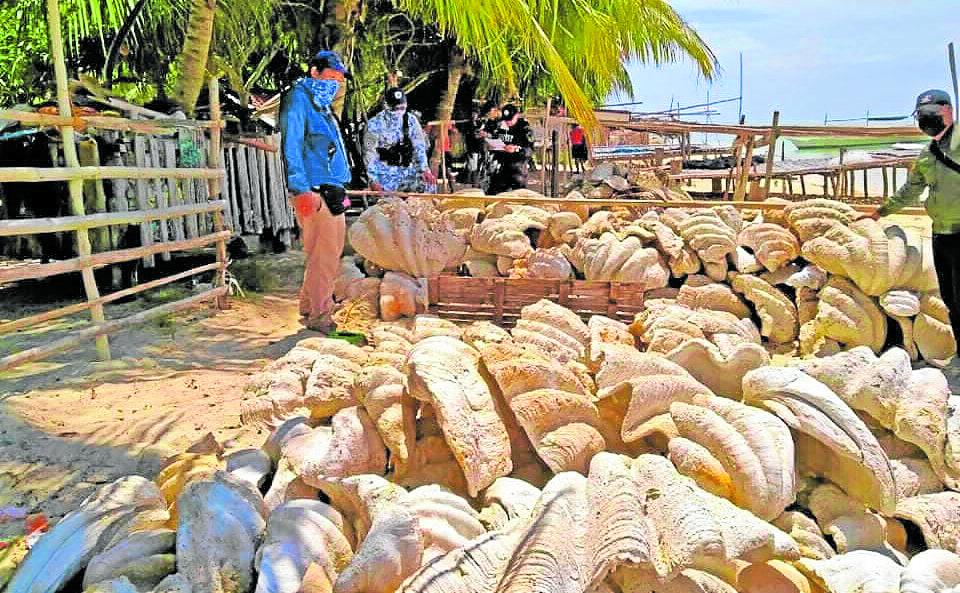P 1.2-B worth of giant clam shells seized in Palawan; 4 nabbed

BIGGEST HAUL A stockpile of around 200 tons of shells of giant clams, locally known as “taklobo” and the largest bivalve mollusk in the world, are seized by local authorities on Green Island in the village of Tumarbong, Roxas, Palawan on Friday, the biggest recovery made by authorities of the endangered species. —PHOTO COURTESY OF THE PHILIPPINE COAST GUARD
PUERTO PRINCESA CITY—About 200 tons of fossilized giant clam shells valued at around P1.2 billion were seized by authorities from four men who were arrested in Palawan province in the biggest recovery so far of the bivalves which are much-coveted for their ivory-like qualities.
The Philippine Coast Guard (PCG) said in a statement on Saturday that the four—Rey Cuyos, 54; Rodolfo Rabesa, 48; Julius Molejoa, 47; and Erwin Miagao, 40—would be charged with violating Republic Act No. 9147, or the Wildlife Resources Conservation and Protection Act, and Republic Act No. 8850, or the Philippine Fisheries Code.
The men were arrested at Sitio Green Island in the coastal village of Tumarbong in Roxas town around noon on Friday, the PCG said.
The suspects allegedly harvested the giant clams from the waters around the towns of Taytay, El Nido, Roxas and neighboring island towns, according to the PCG.
The giant clams recovered in Roxas were by far the largest seizure made by authorities in the province who, along with conservation groups, had been in constant battle with poachers and traders who prey on protected marine and other land-based endangered species that still abound in Palawan.
More Palawan finds
Only last Tuesday, local officials seized at least 26 tons of abandoned giant clam shells, estimated at around P57 million from a coastal community in the southern Palawan town of Narra. The people who abandoned the shells have not been identified.
On Feb. 6, 90 pieces of abandoned giant clam shells were also found at Barangay Sibaltan in El Nido town.
On Nov. 24, 2020, about 25,000 kilos of giant clam shells worth P25 million were seized at Sitio Dandulit in the village of Buliluyan in the southern Palawan municipality of Bataraza.
Jovic Fabello, spokesperson for the Palawan Council for Sustainable Development (PCSD), said in a phone interview on Saturday that they suspected that the poaching and trading of giant clams was being done by an organized group.
Fabello said authorities were hot on the trail of this group that has reportedly been offering a “national redemption program” for fossilized giant clam shells.
P2,000 per kilo
The PCSD is a government environmental agency dedicated to protecting the natural resources of the island province.
Local fishermen claim that the giant clam shells were being sold for up to P2,000 per kilo, enough enticement to join the illegal trade that involves buyers who smuggle the shells into China, Japan and Europe, Fabello said.
“Due to the pandemic and poverty, news about the illegal trade would have traveled like wildfire because of the high price [that the shells fetch],” he said.
Strictly monitored
“They say there is a ship that picks up the giant clams in Linapacan. A really big sea vessel, probably a ship, that they use because the ‘taklobo’ (giant clam) is heavy,” Fabello said.
Linapacan, which is part of the Calamian Islands, is an island town in northeastern Palawan located betwen El Nido and Coron.
With the global illegal ivory trade now strictly monitored in certain African and Asian countries, wildlife traders were believed to have turned to the fossilized giant clam shells as a substitute, according to Fabello.
“They use these [shells] to carve [decorative items], others are turned into imitation pearls and, one group said, they are turned into powder because it is made of calcium carbonate and has medicinal value,” he said.
Close to extinction
The waters of Palawan have a natural population of giant clams, which can grow a shell up to 1.4 meters long.
The giant clams came close to extinction in the 1980s due to indiscriminate harvesting by locals for food and shellcraft until strict laws were enforced, such as RA 9147, which was enacted in March 2001, to protect the species.
Groups like the Malampaya Foundation Inc. (MFI) released over 600 juvenile giant clams at a marine protected area of Cadlao Island, El Nido, in October last year to boost the population of the Tridacna gigas species that had been depleted by poachers.
MFI, through its String-of-Pearls program, has been restocking the giant clam population in partnership with the Western Philippines University and the PCSD. INQ